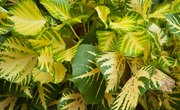
Science experiments with plants teach us the process of plant growth and the effects on our environment. From growing small seeds in a bottle to playing music in a plant's surroundings, plant science experiments can be used to help us make connection between us and other living organisms on the earth. Observing plants and their living conditions can give us insight on how our own bodies work, and how outside factors can affect our everyday lives.
Growing Bean Plant Experiment
The growing bean plant experiment involves recyclable plastic bottles, soil, paper towels and beans. To conduct this experiment, the plastic bottle must first be cut 3/4 of the way down from the top, and holes need to be made at the bottom of the bottle. Paper towels are then placed against the inner wall of the plastic bottle, and the space remaining in the middle of the bottled is filled with soil. After adding the soil, bean seeds are placed between the wall of the plastic bottle and the paper towel, making them visible from the outside. Water is then added to the bottle to hydrate the bean seeds and aid in the growth process. This simple plant project aims at teaching the process of plant germination and how seeds need to be nursed and cared for in order to properly grow.
Carnation Flower Plant Experiment
Plant stems play an important role in the growth of a plant, as they absorb water and allow the plant to grow and thrive. The carnation plant experiment teaches both children and adults this process by placing the flowers in colored water. A cup is filled 3/4 of the way with water, then three to four drops of food coloring are added. The stem of the carnation is cut at the bottom and placed inside of the cup, where it sits for four days and absorbs the food coloring. During these four days, the carnation's petals begin to change into the color of the water. When the carnation flower is taken out of the cup and the stem is turned right side up, the process of absorption is presented through the bottom pores of the stem.
Music and Three Plants Experiment
The music and three plant experiment works much like how parents use music on infants to stimulate their brain, except that it focuses on plant growth. Three different plants are placed in three different areas of the home, along with three different methods of sound: classical music, rock music and silence. The plants that are placed with classical and rock music must bebexposed to the music for the majority of the day while being cared for. The plant that is placed in a silent area continues to be cared for as well. After two weeks, all three plants are placed together to compare and observe how each method of sound has affected the plant's ability to develop. This plant experiment exhibits how sound or noise in a vicinity can hinder plant growth. Plants that are exposed to loud noises, such as in the city, may not grow as well as those growing in a quiet countryside.
References
About the Author
Anya Meave is a freelance writer from San Diego, Calif. She began writing in 2009 for various websites. Majoring in telemedia, she has written scripts for student projects and has been chosen to submit a spec script for the 2011 Nickelodeon Writers Fellowship. Meave has an associate degree in photography from Southwestern College.
